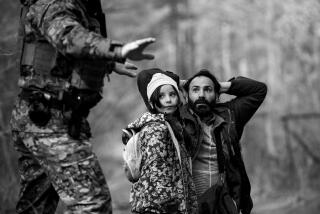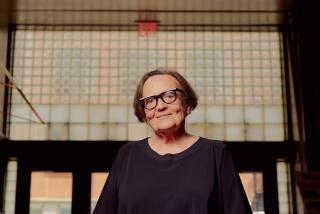Cannes entry ‘Cold War’ marks Pawel Pawlikowski’s return three years after the Oscar winning ‘Ida’
Reporting from Cannes, France — Pawel Pawlikowski is not a director who likes to repeat himself, not one little bit.
“Each film should be going further somehow. I want to be stimulated formally as well as emotionally,” he says. “If you step back, it could be a sign you shouldn’t be making films anymore.”
So after winning the foreign-language film Oscar in 2015 for the luminous “Ida” — a black-and-white picture set in Communist-era Poland — you would have bet money that Pawlikowski’s next film would be anything but that.
And you would have been wrong.
For the director, resting his recently broken foot in his quiet hotel room, is in competition at this year’s Cannes film festival with “Cold War,” another gorgeous black-and-white film set in Communist-era Poland.
What changed his mind? The last three words seen on screen tell the tale: “For my parents.”
“Cold War,” set on both sides of the Iron Curtain, is the culmination of the filmmaker’s nearly 10-year search for a way to bring the essence of his parents’ beyond-tumultous personal history to the screen. He’s even given the protagonists his parents’ first names: Wiktor and Zula.
“As a teenager I thought my parents were something to be embarrassed about, but as an adult I think they were the most interesting people I’ve ever known,” Pawlikowski says.
“Their love story in Warsaw and London was very complicated. Marriage, betrayal, divorce, marriage again, divorce again. And they died just before the Berlin Wall came down.
“They were two equally strong people, dependent on each other but couldn’t stand each other. They shared love and the inability to be with each other. Neither was a pushover, nobody gave in. I couldn’t have made the film if they were alive, I’d be censoring myself too much.
“When I told all this to [Mexican director] Alfonso Cuarón at Telluride a few years ago, he said to me, ‘It’s such a good story, you have to do it.’ ”
In truth, in the emotional tone of the tale it tells and even in the nature of its black-and-white look, “Cold War” is very different from “Ida.”
Taking place between 1949 and 1964, mainly in Warsaw, Paris and rural Poland with stops in East Berlin and Split, Yugoslavia, “Cold War” is an impeccably made star-crossed love story — haunting, atmospheric, passionate and tempestuous.
And it is ambitious as well in the way it links the specifics of the Wiktor/Zula relationship to larger questions like the ramifications of love and the cost of exile.
One thing the two films do have in common is the fascination that Pawlikowski — whose mother brought him to London at age 14 without telling him the move was permanent — has with the nature of Communist society.
“It was so paradoxical, so surreal, the use of authoritarian ideas to turn people into something they can’t be. There’s this element of crazy idealism combined with cynicism and careerism and the way people were afraid.”
Turning the essence of his parent’s story into a film was a gradual process that started with the realization that “I had to get away from the specifics and think of the characters as a separate couple with the same mechanics.”
Pawlikowski chose to set his story in an a fictional version of the Mazowsze folk ensemble, which became celebrated in the Communist era for doing crowd-pleasing, uptempo versions of traditional Polish folk songs and dances.
Wiktor (Tomasz Kot) is introduced as one of the founders of the troupe (which still exists), while Zula (Joanna Kulig) is a gifted singer who knows how to play the angles.
“I was surrounded by it as a kid; it was shoved down everyone’s throats,” he explains of the music. “But with age you get nostalgic about everything you couldn’t stand as a kid.”
A filmmaker who is constantly paring his work (“Cold War” clocks in at under 90 minutes), Pawlikowski also felt it was essential to tell this story obliquely, without filling in all the blanks.
“As a viewer, if I can see where buttons are being pressed, I find that boring, so I don’t want to explain or psychologize everything,” he says. “The only way to do it without having bad scenes is to do it elliptically.”
Pawlikowski shot one excessively explanatory scene, which he did not use. “I got cold feet. But it became a piece of British realist drama; it destroyed the magic of the film.”

Shooting in black and white (Oscar-nominated cinematographer Lukasz Zal returns from “Ida”) was a similarly pragmatic decision.
Because of the vivid nature of the folk ensemble, Pawlikowski initially planned to shoot in color. “But I couldn’t find color that would do justice to that. Saturated American color seemed wrong for the period, and for a while I thought of using Soviet technicolor, with washed out reds and greens, but that seemed mannered.
“The most honest thing was to stick to black and white, but a black and white that was more dramatic, more contrasty than ‘Ida.’ ”
Although it won’t be next, Pawlikowski, who moved back to Poland in 2013 to make “Ida” and has never left, says another film in that country is possible.
“It’s a horrible place now, ‘Ida’ is banned, but all the more reason to stay there,” he says of the current nationalistic political situation. “But the battle isn’t lost: Poland is more chaotic, more cantankerous; there is resistance of all sorts.
“It’s important to make films there, to show how complicated the human soul is.”
More to Read
Only good movies
Get the Indie Focus newsletter, Mark Olsen's weekly guide to the world of cinema.
You may occasionally receive promotional content from the Los Angeles Times.










